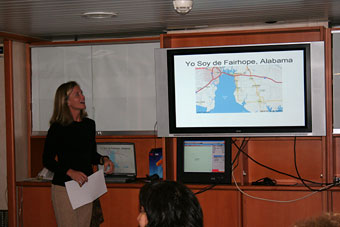

 | |||||||||
|
|
Journals 2007/2008Megan O'Neill
August 5, 2007 This morning our location was 75°18'N latitude and 13°54'E longitude. We were moving to core site #3 at 7.8 knots and our heading was 138 degrees N. The depth in the area was just over 1,000 m. The plan was to attempt core #3 at 8:30 am and then move to core site #4 and collect that one in the afternoon. Core #2 was supposed to have been collected along a slope, but the target was overshot and we collected on top of the slope. Therefore, core #3 was another attempt at getting closer to the planned site. Angelo mentioned that on most ships the coring would be done around the clock once started, but this is when you have more than one team of drill technicians. We only have one crew and it is too exhausting to collect more than two per day at this depth. Once we arrived at the planned location, the drilling began. The site that was actually shot was at 75.22232°N and 14.61987°E at a depth of 773 m. When the core was recovered the trigger core had approximately 1 m of dense sediment and 6.4 2m were recovered from the main core portion. This information was logged and the cores were placed in the large industrial refrigerator. The cores are kept in the refrigerator at 4°C (the approximate temperature of the water at the bottom of all oceans) to preserve them until they will be taken to the University of Barcelona to be opened and studied. They will be looking for microscopic organism fossils that will indicate the age of the sediments. Angelo believes that this research will begin in January 2008 back at their lab. He will then send the results that they uncover because we are not able to view the samples currently in the cores. At 12:30 pm, I gave a short presentation on my home, school and the ARMADA Project to the scientists. I wanted to share my part of the world with them through pictures and explain why I was here with them. With Catalina's help, I attempted several parts of it in Español. Everyone got a large laugh when I mistakenly referred to the picture of my horses as "caballeros" instead of "caballos". I was told that "caballeros" means the "men that ride the horses"! I am still learning my Español! In the afternoon, we moved to the site of core #4 and attempted the collection. We actually had to abandon this attempt because of swells in the ocean that were making working conditions on the deck unsafe for the drilling crew. Angelo instructed the crew to wait for tomorrow morning to see if conditions would be better and we would continue our survey of the ocean floor.
|
||||||||
